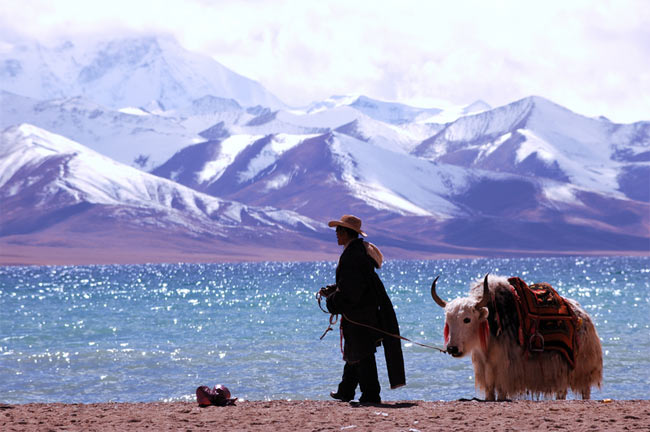Tibetans Underwent Fastest Evolution Seen in Humans

Life at high altitudes forced ancient Tibetans to undergo the fastest evolution ever seen in humans, according to a new study.
The most rapid genetic change showed up in the EPAS1 gene, which helps regulate the body's response to a low-oxygen environment. One version, called an allele, of the EPAS1 gene changed in frequency from showing up in 9 percent of the Han Chinese to 87 percent of Tibetans.
Such genetic changes suggest Tibetan ancestors split off from the Han Chinese population about 2,750 years ago, researchers say. But only those most evolutionarily suited for life at high altitudes survived when they moved to the Tibetan Plateau.
"It took only a few hundred generations to change the allele frequency, which can only happen if a lot of people have died," said Rasmus Nielsen, an evolutionary biologist at the University of California at Berkeley. "In that sense, it must have had a strong effect on fitness."
The Tibetan example of human evolution beats the previous record holders in northern Europe, who evolved lactose tolerance to digest the milk sugar lactose over the course of about 7,500 years.
Exactly how the EPAS1 allele helps humans adapt to oxygen deprivation remains unknown. But the study suggests that most Han Chinese who could not adapt to high-altitude environments did not do well in passing on their genes.
From lowlands to mountains
Sign up for the Live Science daily newsletter now
Get the world’s most fascinating discoveries delivered straight to your inbox.
Modern Tibetans have evolved to survive the thin air (molecules of air become less tightly packed with altitude) without making more red blood cells and hemoglobin, which is the protein that helps carry oxygen in the blood.
By contrast, a lowlander would eventually see his or her body compensate for the lack of oxygen by developing more red blood cells and hemoglobin. That helps them deal with 40-percent lower oxygen levels compared with sea level at elevations above 13,000 feet (3,962 meters).
"If we go to high altitude, we produce more hemoglobin, but there's a cost to that," Nielsen told LiveScience. "Tibetans can perform even better without the extra hemoglobin."
Too much hemoglobin can lead to chronic altitude sickness, which involves thick and viscous blood. Lowlanders still end up tiring more easily, developing headaches, having babies with lower birth weights and also suffering higher infant mortality rates.
Nielsen and his colleagues in Europe and China focused on tracing the evolutionary lineage of Tibetans, rather than starting with the physiological changes that have made modern Tibetans so well-adapted to high altitudes.
"Usually you'd take a lot of Tibetans who respond well to oxygen deprivation and those who don't, and try to find a genetic difference," Nielsen explained. "We did it the other way around."
Counting the differences
The study sequenced 92 percent of the genomes of 50 non-related Tibetans living in two villages within the Tibet Autonomous Region of China, as well as 40 Han Chinese from Beijing. The Tibetan villages were located at elevations of 14,100 feet (4,300 meters) and 15,100 feet (4,600 meters).
The data came from the Beijing Genomics Institute (BGI) in Shenzhen, which Nielsen described as the biggest sequencing center in the world and capable of beating any Western counterparts.
Chinese researchers also used blood samples to measure oxygen saturation, red blood cell concentration and hemoglobin levels, so they could compare physiological changes tied to genetic differences.
Results revealed about 30 genes with mutations that had become more common in Tibetans than in Han Chinese. Nearly half of those related to how the body uses oxygen.
The most dramatic example of change came from a mutation carried by one of the EPAS1 alleles. Tibetans with two mutated alleles – one from each parent – had significantly lower hemoglobin concentrations and could still do well at high altitudes.
But researchers could not say for sure whether the Tibetans had evolved away from the Han Chinese or vice versa. They needed a third group for comparison.
That group came in the form of 200 Danes, whose genomes had almost zero percent of the EPAS1 allele thought to be adaptive for high altitudes. The data combined with simulations to suggest the Tibetans had undergone major genetic changes.
Tracing lineage
Questions remain about not only the physiological adaptations that make Tibetans fit for high-altitude living, but also about the Tibetan ancestors and their origin.
The genetic analysis suggests the larger group of Tibetans that moved to the Tibetan Plateau some 2,750 years ago eventually shrank, while the smaller group that moved to the lower elevations expanded greatly into the modern-day Han Chinese population.
Historical evidence shows that people have lived on the Tibetan Plateau for longer than 3,000 years, Nielsen noted. He and his colleagues speculate the Tibetans either merged with the people already living on the plateau, or replaced them.
Either way, Nielsen said the study has no relevance for the ongoing debate over whether Tibet belongs as part of China. Ethnic groups define themselves by culture and history, he added.
"I'm from Denmark and probably genetically indistinguishable from someone from Sweden, but doesn't mean they're the same country," Nielsen said. "I'd argue that genetics is irrelevant to Tibetan self-determination."
- 7 Amazing Superhuman Feats
- History's Most Overlooked Mysteries
- Gallery: Everest Expedition










